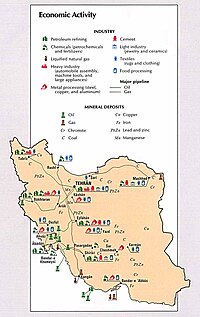
Photo from wikipedia
Abstract The Shahr-e-Babak region located in the Kerman metallogenic belt is one of the high potential segments of Urumieh–Dokhtar magmatic arc for porphyry copper and epithermal gold mineralization in the… Click to show full abstract
Abstract The Shahr-e-Babak region located in the Kerman metallogenic belt is one of the high potential segments of Urumieh–Dokhtar magmatic arc for porphyry copper and epithermal gold mineralization in the south of Iran. This high potential zone encompasses several porphyry copper deposits under exploitation, development and exploration stages. The aim of this study is to evaluate Landsat-8 data and comparison with the Advanced Spaceborne Thermal Emission and Reflection Radiometer data-sets for mapping hydrothermal alteration zones related to Cenozoic magmatic intrusions in Shahr-e-Babak region. Previous studies have proven the robust application of ASTER in lithological mapping and mineral exploration; nonetheless, the Landsat-8 data have high capability to map and detect hydrothermal alteration zones associated with porphyry copper and epithermal gold mineralization. In this investigation, several band combinations and multiplications, developed selective principal component analysis and image transformations were developed for discriminating hydrothermal alteration zones associated with porphyry copper mineralization using Landsat-8 data.
Journal Title: Geocarto International
Year Published: 2018
Link to full text (if available)
Share on Social Media: Sign Up to like & get
recommendations!